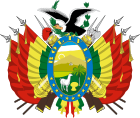| Revision as of 03:47, 5 May 2008 editNlu (talk | contribs)Administrators163,869 editsm Changing POV language← Previous edit | Revision as of 13:59, 8 May 2008 edit undoСанта Клаус (talk | contribs)Rollbackers213 editsm arabic interwiki مشروع التوصيل يمكنك المشاركة والمساعدة!Next edit → | ||
| Line 40: | Line 40: | ||
| <!--Other languages--> | <!--Other languages--> | ||
| ] | |||
| ] | ] | ||
| ] | ] | ||
Revision as of 13:59, 8 May 2008
|

|
| Politics of Bolivia |
|---|
 |
| Constitution |
| Executive |
| Legislative |
| Judiciary |
Elections
|
| Administrative divisions |
|
Foreign relations
|
|
|
|} Bolivia is divided into 9 departments (Spanish: departamentos). These are (with their capitals indicated in parentheses):
- Beni (Trinidad)
- Chuquisaca (Sucre)
- Cochabamba (Cochabamba)
- La Paz (La Paz)
- Oruro (Oruro)
- Pando (Cobija)
- Potosí (Potosí)
- Santa Cruz (Santa Cruz de la Sierra)
- Tarija (Tarija)
Each of the departments is subdivided into provinces (provincias), which are further subdivided into municipalities (municipios).
The Antofagasta Region in Chile is considered on the country's constitution to be a captive 10th department called "Litoral."
On 2007-12-15, Santa Cruz, Beni, Pando and Tarija declared autonomy from the central government, citing President Evo Morales' support for the country's indigenous population as their motivation, a move considered illegal by the federal government.
See also
- Ranked list of Bolivian departments
- ISO 3166-2:BO, the ISO codes for the departments of Bolivia.
References
- Four Bolivian regions declare autonomy from government, CNN.com, 2007-12-16.
- Dueling rallies spotlight Bolivian split, LA Times, 2007-12-16.
| Departments of Bolivia | ||
|---|---|---|
Template:South America administrative divisions
Categories: